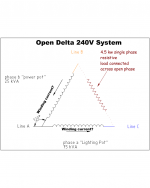So how much of the 4500 W load would each transformer carry?
Here is a better diagram:
View attachment 2567623
As Wayne mentioned, if you put a single phase load across BC, all of that load current will flow through the AB winding.
Also as mentioned, that BC load current is at 60° from the AB voltage.
Now if you also place a resistive load across AB, the two load currents will be at a 60° from each other. And so if you have a 4.5 kW load across AB and a 4.5 kW load across BC, instead of doubling the AB winding current it will be √3 ≈ 1.732 times instead. But to be conservative, you could just add the AB and BC load currents to get the current drawn from terminal B of the AB winding in the open delta.
If you want to get into more detailed calculations:
Let I
B be the load current at terminal B of the open delta, and I
AB and I
BC be the currents through resistive loads across AB and BC respectively.
Also let I
C be the load current at terminal C of the open delta, and I
AC and I
BC be the currents through resistive loads across AC and BC respectively.
I
B2 = I
AB2 + I
BC2 + I
AB x I
BC
I
C2 = I
AC2 + I
BC2 + I
AC x I
BC
If you want to fully load the AB winding to its rated current I
Bmax when there's already a load current across the open jaw of I
BC, then allowable load current across AB would be:
I
AB = 0.5 x
[ √ ( 4 I
Bmax2 - 3 I
BC2) - I
BC ]
Similary, the allowable load current placed across AC when the AC winding is rated at I
Cmax and with a load current across the open jaw of I
BC is:
I
AC = 0.5 x
[ √ ( 4 I
Cmax2 - 3 I
BC2) - I
BC ]
Since the L-L voltages are the same, you can substitute kVA for all currents in these equations.
Here's some examples of the maximum single phase L-L loading on both the 25 kVA power pot and 75 kVA lighing pot, with numbers in kVA:
| BC load | AB load | AC load | Total load |
| 0.0 | 25.0 | 75.0 | 100.0 |
| 12.5 | 16.3 | 68.0 | 96.8 |
| 14.4 | 14.4 | 66.7 | 95.5 |
| 25.0 | 0.0 | 59.3 | 84.3 |

